2016 SUBARU OUTBACK Acc switch
[x] Cancel search: Acc switchPage 9 of 572
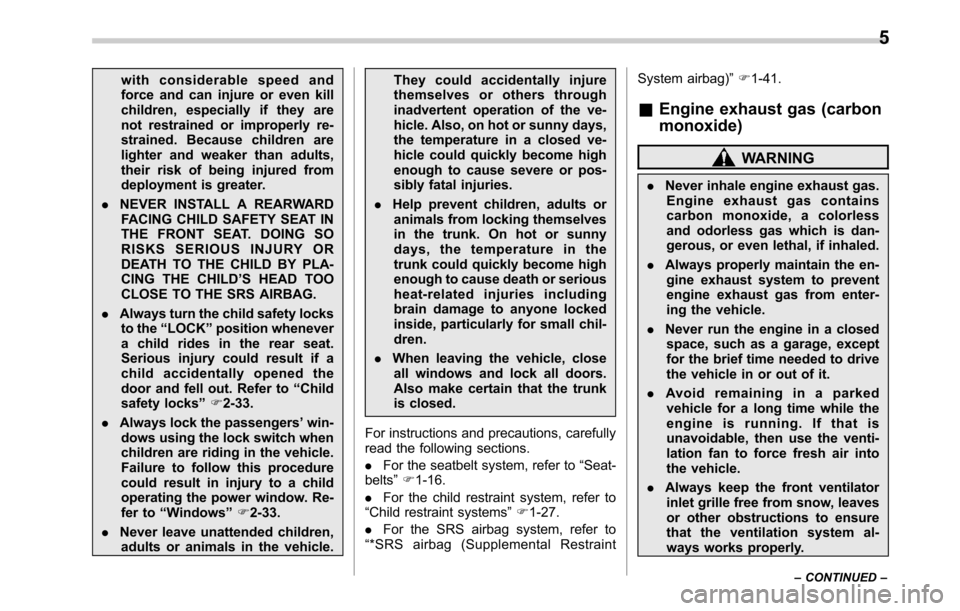
with considerable speed and
force and can injure or even kill
children, especially if they are
not restrained or improperly re-
strained. Because children are
lighter and weaker than adults,
their risk of being injured from
deployment is greater.
.NEVER INSTALL A REARWARD
FACING CHILD SAFETY SEAT IN
THE FRONT SEAT. DOING SO
RISKS SERIOUS INJURY OR
DEATH TO THE CHILD BY PLA-
CING THE CHILD’S HEAD TOO
CLOSE TO THE SRS AIRBAG.
.Always turn the child safety locks
to the“LOCK”position whenever
a child rides in the rear seat.
Serious injury could result if a
child accidentally opened the
door and fell out. Refer to“Child
safety locks”F2-33.
.Always lock the passengers’win-
dows using the lock switch when
children are riding in the vehicle.
Failure to follow this procedure
could result in injury to a child
operating the power window. Re-
fer to“Windows”F2-33.
.Never leave unattended children,
adults or animals in the vehicle.They could accidentally injure
themselves or others through
inadvertent operation of the ve-
hicle. Also, on hot or sunny days,
the temperature in a closed ve-
hicle could quickly become high
enough to cause severe or pos-
sibly fatal injuries.
.Help prevent children, adults or
animals from locking themselves
in the trunk. On hot or sunny
days, the temperature in the
trunk could quickly become high
enough to cause death or serious
heat-related injuries including
brain damage to anyone locked
inside, particularly for small chil-
dren.
.When leaving the vehicle, close
all windows and lock all doors.
Also make certain that the trunk
is closed.
For instructions and precautions, carefully
read the following sections.
.For the seatbelt system, refer to“Seat-
belts”F1-16.
.For the child restraint system, refer to
“Child restraint systems”F1-27.
.For the SRS airbag system, refer to
“*SRS airbag (Supplemental RestraintSystem airbag)”F1-41.
&Engine exhaust gas (carbon
monoxide)
WARNING
.Never inhale engine exhaust gas.
Engine exhaust gas contains
carbon monoxide, a colorless
and odorless gas which is dan-
gerous, or even lethal, if inhaled.
.Always properly maintain the en-
gine exhaust system to prevent
engine exhaust gas from enter-
ing the vehicle.
.Never run the engine in a closed
space, such as a garage, except
for the brief time needed to drive
the vehicle in or out of it.
.Avoid remaining in a parked
vehicle for a long time while the
engine is running. If that is
unavoidable, then use the venti-
lation fan to force fresh air into
the vehicle.
.Always keep the front ventilator
inlet grille free from snow, leaves
or other obstructions to ensure
that the ventilation system al-
ways works properly.
–CONTINUED–
5
Page 17 of 572

CVT models1) Select lever (page 7-26)
2) Climate control (page 4-1)
3) Audio (page 5-1)/Navigation system (Re-
fer to the Owner’s Manual supplement for
the navigation system)
4) Glove box (page 6-6)
5) Accessory power outlet (page 6-10)
6) Cup holder (page 6-8)
7) Electronic parking brake switch
(page 7-42)
8) X-mode switch (page 7-39)
9) Hill Holder switch (page 7-45)
–CONTINUED–
13
Page 18 of 572
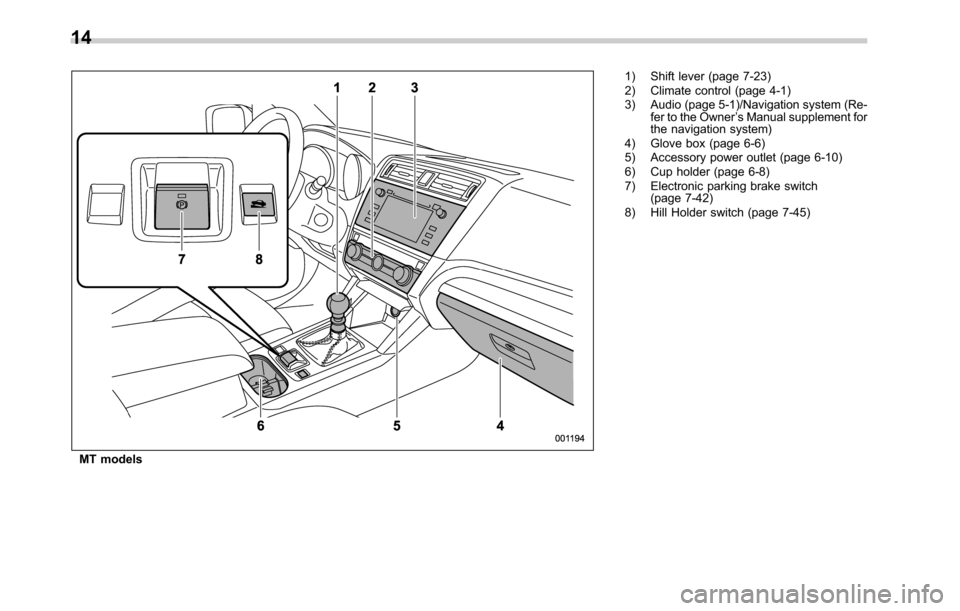
MT models1) Shift lever (page 7-23)
2) Climate control (page 4-1)
3) Audio (page 5-1)/Navigation system (Re-
fer to the Owner’s Manual supplement for
the navigation system)
4) Glove box (page 6-6)
5) Accessory power outlet (page 6-10)
6) Cup holder (page 6-8)
7) Electronic parking brake switch
(page 7-42)
8) Hill Holder switch (page 7-45)
14
Page 36 of 572
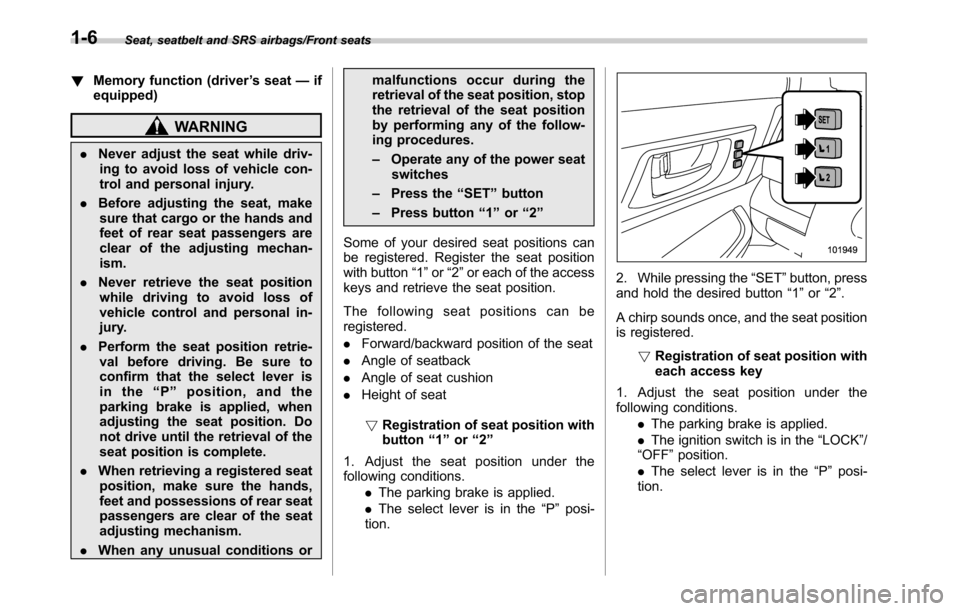
Seat, seatbelt and SRS airbags/Front seats
!Memory function (driver’s seat—if
equipped)
WARNING
.Never adjust the seat while driv-
ing to avoid loss of vehicle con-
trol and personal injury.
.Before adjusting the seat, make
sure that cargo or the hands and
feet of rear seat passengers are
clear of the adjusting mechan-
ism.
.Never retrieve the seat position
while driving to avoid loss of
vehicle control and personal in-
jury.
.Perform the seat position retrie-
val before driving. Be sure to
confirm that the select lever is
in the“P”position, and the
parking brake is applied, when
adjusting the seat position. Do
not drive until the retrieval of the
seat position is complete.
.When retrieving a registered seat
position, make sure the hands,
feet and possessions of rear seat
passengers are clear of the seat
adjusting mechanism.
.When any unusual conditions ormalfunctions occur during the
retrieval of the seat position, stop
the retrieval of the seat position
by performing any of the follow-
ing procedures.
–Operate any of the power seat
switches
–Press the“SET”button
–Press button“1”or“2”
Some of your desired seat positions can
be registered. Register the seat position
with button“1”or“2”or each of the access
keys and retrieve the seat position.
The following seat positions can be
registered.
.Forward/backward position of the seat
.Angle of seatback
.Angle of seat cushion
.Height of seat
!Registration of seat position with
button“1”or“2”
1. Adjust the seat position under the
following conditions.
.The parking brake is applied.
.The select lever is in the“P”posi-
tion.
2. While pressing the“SET”button, press
and hold the desired button“1”or“2”.
A chirp sounds once, and the seat position
is registered.
!Registration of seat position with
each access key
1. Adjust the seat position under the
following conditions.
.The parking brake is applied.
.The ignition switch is in the“LOCK”/
“OFF”position.
.The select lever is in the“P”posi-
tion.
1-6
Page 37 of 572
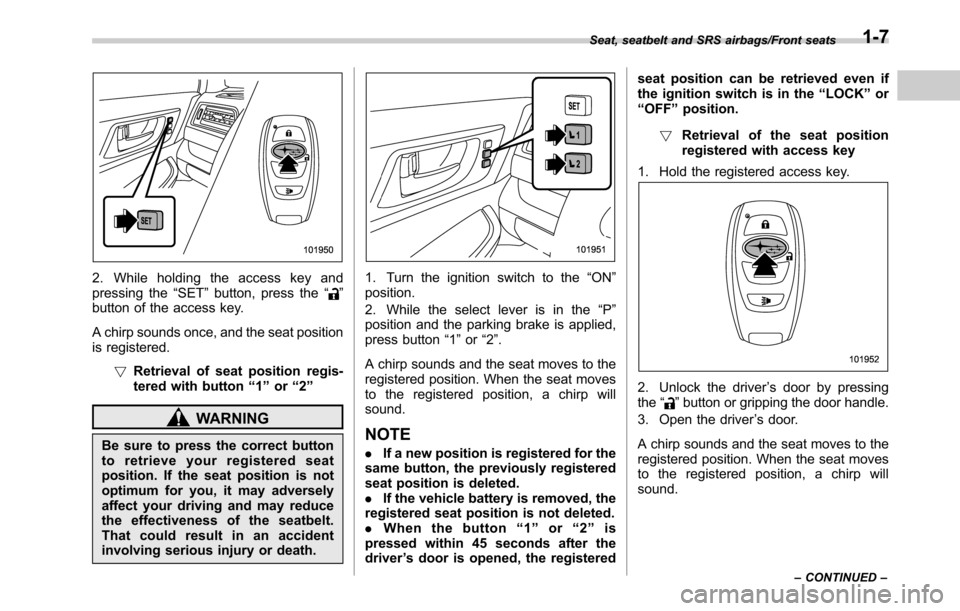
2. While holding the access key and
pressing the“SET”button, press the“”
button of the access key.
A chirp sounds once, and the seat position
is registered.
!Retrieval of seat position regis-
tered with button“1”or“2”
WARNING
Be sure to press the correct button
to retrieve your registered seat
position. If the seat position is not
optimum for you, it may adversely
affect your driving and may reduce
the effectiveness of the seatbelt.
That could result in an accident
involving serious injury or death.
1. Turn the ignition switch to the“ON”
position.
2. While the select lever is in the“P”
position and the parking brake is applied,
press button“1”or“2”.
A chirp sounds and the seat moves to the
registered position. When the seat moves
to the registered position, a chirp will
sound.
NOTE
.If a new position is registered for the
same button, the previously registered
seat position is deleted.
.If the vehicle battery is removed, the
registered seat position is not deleted.
.When the button“1”or“2”is
pressed within 45 seconds after the
driver’s door is opened, the registeredseat position can be retrieved even if
the ignition switch is in the“LOCK”or
“OFF”position.
!Retrieval of the seat position
registered with access key
1. Hold the registered access key.
2. Unlock the driver’s door by pressing
the“”button or gripping the door handle.
3. Open the driver’s door.
A chirp sounds and the seat moves to the
registered position. When the seat moves
to the registered position, a chirp will
sound.
Seat, seatbelt and SRS airbags/Front seats
–CONTINUED–1-7
Page 82 of 572

Seat, seatbelt and SRS airbags/*SRS airbag (Supplemental Restraint System airbag)
waist.
In a moderate to severe side impact
collision, the SRS curtain airbag on the
impacted side of the vehicle deploys
between the occupant and the side
window and supplements the seatbelt by
reducing the impact to the occupant’s
head.
NOTE
The SRS side airbag and seatbelt
pretensioner are not controlled by the
SUBARU advanced frontal airbag sys-
tem.
!Driver’s SRS frontal airbag
The driver’s SRS frontal airbag uses a
dual stage inflator. The inflator operates in
different ways depending on the severity
of impact.
Have the system inspected by your
SUBARU dealer immediately if the SRS
airbag system warning light illuminates.
!Front passenger’s SRS frontal air-
bag
The front passenger’s SRS frontal airbag
uses a dual stage inflator. The inflator
operates in different ways depending on
the severity of impact.
The total load on the seat is monitored by
the passenger’s occupant detection sys-tem sensor located under the seat.
The system has another sensor that
monitors the tension of the front passen-
ger’s seatbelt. Using the total seat load
and seatbelt tension data from the sen-
sors, the occupant detection system de-
termines whether the front passenger’s
SRS frontal airbag should or should not be
inflated.
The occupant detection system may not
inflate the front passenger’s SRS frontal
airbag even when the driver’s SRS frontal
airbag deploys. This is normal.
CAUTION
Observe the following precautions.
Failure to do so may prevent the
SUBARU advanced frontal airbag
system from functioning correctly
or cause the system to fail.
.Do not apply any strong impact
to the front passenger’sseat
such as by kicking.
.Do not let rear passengers rest
their feet between the front seat-
back and seat cushion.
.Do not spill liquid on the front
passenger’s seat. If liquid is
spilled, wipe it off immediately.
.Do not remove or disassemblethe front passenger’s seat.
.Do not install any accessory
(such as an audio amplifier) other
than a genuine SUBARU acces-
sory under the front passenger’s
seat.
.Do not place anything (shoes,
umbrella, etc.) under the front
passenger’s seat.
.Do not use the front passenger’s
seat with the head restraint re-
moved.
.Do not leave any articles on the
front passenger’s seat or the
seatbelt tongue and buckle en-
gaged when you leave your ve-
hicle.
.Do not place a magnet near the
seatbelt buckle and the seatbelt
retractor.
.Do not use front seats with their
backward-forward position and
seatback not being locked into
place securely. If any of them are
not locked securely, adjust them
again. For adjusting procedure,
refer to“Manual seat”F1-4
(models equipped with manual
seats only).
If the seatbelt buckle switch and/or front
1-52
Page 84 of 572

Seat, seatbelt and SRS airbags/*SRS airbag (Supplemental Restraint System airbag)
CAUTION
When the front passenger’s seat is
occupied by an infant in an appro-
priate child restraint system, ob-
serve the following precautions.
Failure to do so may increase the
load on the front passenger’s seat,
activating the front passenger’s
SRS frontal airbag even though that
seat is occupied by an infant.
.Do not place any article on the
seat other than the infant in the
child restraint system.
.Do not place more than one
infant in the child restraint sys-
tem.
.Do not install any accessory
such as a table or TV onto the
seatback.
.Do not store a heavy load in the
seatback pocket.
.Do not allow the rear seat occu-
pant to place his/her hands or
legs on the front passenger’s
seatback, or allow him/her to pull
the seatback.!If the front passenger’s frontal
airbag ON indicator illuminates
and the OFF indicator turns off
even when an infant or a small
child is in a child restraint sys-
tem (including booster seat)
1. Turn the ignition switch to the“LOCK”/
“OFF”position.
2. Remove the child restraint system
from the seat.
3. By referring to the child restraint
manufacturer’s recommendations as well
as the child restraint system installation
procedures in“Child restraint systems”
F1-27, correctly install the child restraint
system.
4. Turn the ignition switch to the“ON”
position and make sure that the front
passenger’s frontal airbag ON indicator
turns off and the OFF indicator illuminates.
If still the ON indicator remains illuminated
while the OFF indicator turns off, take the
following actions.
.Ensure that no article is placed on the
seat other than the child restraint system
and the child occupant.
.Ensure that there is no article left in the
seatback pocket.
.Ensure that the backward-forward po-
sition and seatback of front passenger’s
seat are locked into place securely bymoving the seat back and forth. (Models
equipped with manual seats only)
If the ON indicator still remains illuminated
while the OFF indicator turns off after
taking relevant corrective actions de-
scribed above, relocate the child restraint
system to the rear seat and immediately
contact your SUBARU dealer for an
inspection.
NOTE
When a child who has outgrown a child
restraint system or a small adult is
seated in the front passenger’s seat,
the SUBARU advanced frontal airbag
system may or may not activate the
front passenger’s SRS frontal airbag
depending on the occupant’s seating
posture. Children should always wear a
seatbelt when sitting in the seat irre-
spective of whether the airbag is
deactivated or activated. If the front
passenger’s SRS frontal airbag is acti-
vated (the ON indicator remains illumi-
nated while the OFF indicator turns off),
take the following actions.
.Ensure that no article is placed on
the seat other than the occupant.
.Ensure that there is no article left in
the seatback pocket.
If the ON indicator still remains illumi-
1-54
Page 98 of 572
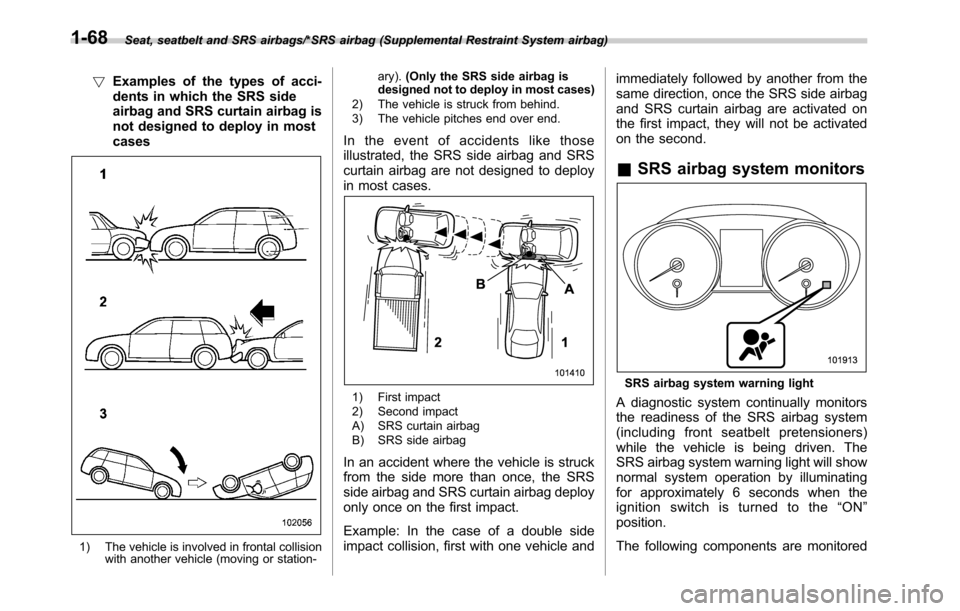
Seat, seatbelt and SRS airbags/*SRS airbag (Supplemental Restraint System airbag)
!Examples of the types of acci-
dents in which the SRS side
airbag and SRS curtain airbag is
not designed to deploy in most
cases
1) The vehicle is involved in frontal collision
with another vehicle (moving or station-ary).(Only the SRS side airbag is
designed not to deploy in most cases)
2) The vehicle is struck from behind.
3) The vehicle pitches end over end.
In the event of accidents like those
illustrated, the SRS side airbag and SRS
curtain airbag are not designed to deploy
in most cases.
1) First impact
2) Second impact
A) SRS curtain airbag
B) SRS side airbag
In an accident where the vehicle is struck
from the side more than once, the SRS
side airbag and SRS curtain airbag deploy
only once on the first impact.
Example: In the case of a double side
impact collision, first with one vehicle andimmediately followed by another from the
same direction, once the SRS side airbag
and SRS curtain airbag are activated on
the first impact, they will not be activated
on the second.
&SRS airbag system monitors
SRS airbag system warning light
A diagnostic system continually monitors
the readiness of the SRS airbag system
(including front seatbelt pretensioners)
while the vehicle is being driven. The
SRS airbag system warning light will show
normal system operation by illuminating
for approximately 6 seconds when the
ignition switch is turned to the“ON”
position.
The following components are monitored
1-68